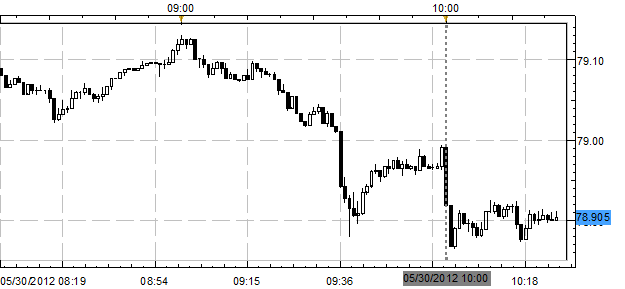The US economy is starting to show signs of stress in the housing sector again. After yesterday’s S&P/Case-Shiller index showed that housing prices dropped to their lowest post-crisis (2008) levels, today’s Pending Home Sales reading for April has solidified concerns. From March, sales dropped by 5.5 percent, while on a yearly-basis sales increased by 14.7 percent. According to a Bloomberg News survey, market participants were expecting no change in the monthly reading, but were anticipating a massive 22.0 percent increase year-over-year. Even in comparison to the prior figures, which were revised down to 3.8 percent m/m (from 4.1 percent) and 10.5 percent y/y (from 10.8 percent), it’s clear that this report was all-around disappointing.
This data is even more discouraging when considering mortgage rates, which Zillow reported yesterday, had fallen to 3.60 percent. As noted previously, it is our firm belief that the housing market has not bottomed yet. If housing sales are continuing to fall even as mortgage rates remain at record lows, it’s clear that buyers are waiting for prices to drop lower; and until prices drop further, the housing market won’t have a sustained rate of demand to suggest a bottom is in place. This in turn could lead the Federal Reserve to try and ease tensions further, in the form of mortgage back security (MBS) purchases, which in theory should helping lending.
USDJPY 1-minute Chart: May 30, 2012

Following the release, the US Dollar was sold off across the board, as it’s clear that market participants have raised their expectations for another round of quantitative easing by the Fed. Typically, and as was the case today, when QE hopes arise, the Japanese Yen tends to benefit as the “most palatable” safe haven, relatively speaking. The USDJPY, which was already down over 0.60 percent on the day, fell from just below 79.00 to a fresh session low of 78.87. This is the lowest exchange rate that the USDJPY has traded at since February 16.
USDJPY declines should be supported by 78.65, the 200-DMA. As Currency Strategist Michael Boutros notes, the “sweet spot” for the USDJPY rests in the 78.65 to 79.10/15 area, and we both expect this area to mark a major inflection point for the currency. That is to say, that a break below 78.65 could lead to a quick move towards 77.00, whereas consolidation in this zone should form a base for a move back towards 85.00. This view is invalidated should the Federal Reserve announce another round of QE, which would dilute the value of the US Dollar and send investors back into the Japanese Yen as the favored safe haven (that is until the Bank of Japan steps in to intervene itself).